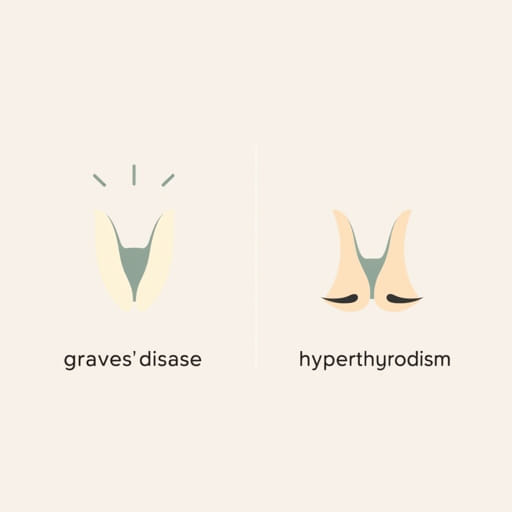When it comes to understanding thyroid disorders, many people often confuse Graves’ disease and hyperthyroidism. While they are closely related and share several symptoms, they are not the same condition. Recognizing the distinction between Graves’ disease vs hyperthyroidism is crucial for accurate diagnosis and proper treatment. This topic will explore the causes, symptoms, diagnostic methods, and treatment options for both conditions in a clear and accessible manner.
Understanding Hyperthyroidism
What is Hyperthyroidism?
Hyperthyroidism is a medical condition that occurs when the thyroid gland produces an excessive amount of thyroid hormones, namely thyroxine (T4) and triiodothyronine (T3). These hormones regulate the body’s metabolism, and when they are present in high levels, they speed up bodily functions such as heart rate, digestion, and energy consumption.
Causes of Hyperthyroidism
There are several potential causes of hyperthyroidism, including:
- Graves’ disease the most common cause
- Toxic multinodular goiter
- Thyroid nodules (autonomous functioning)
- Thyroiditis (inflammation of the thyroid)
- Excessive iodine intake
- Overmedication with thyroid hormone
Common Symptoms of Hyperthyroidism
Symptoms of hyperthyroidism can vary from person to person, but they often include:
- Unexplained weight loss
- Increased appetite
- Rapid or irregular heartbeat
- Nervousness or irritability
- Heat intolerance
- Excessive sweating
- Tremors in the hands
- Fatigue and muscle weakness
- Menstrual irregularities
Understanding Graves’ Disease
What is Graves’ Disease?
Graves’ disease is an autoimmune disorder and the most common cause of hyperthyroidism. In this condition, the body’s immune system mistakenly attacks the thyroid gland, causing it to produce excess thyroid hormones. The presence of autoantibodies called thyroid-stimulating immunoglobulins (TSI) leads to overstimulation of the thyroid gland.
What Makes Graves’ Disease Unique?
Graves’ disease is distinct from other causes of hyperthyroidism because it is specifically an autoimmune disorder. It often comes with additional symptoms not typically seen in other forms of hyperthyroidism, such as:
- Graves’ ophthalmopathy (bulging eyes)
- Thickening of the skin over the shins (pretibial myxedema)
- Goiter (enlarged thyroid)
Risk Factors for Graves’ Disease
Certain factors may increase the risk of developing Graves’ disease:
- Genetic predisposition
- Gender (more common in women)
- Age (typically between 3050)
- Stress
- Smoking
- Other autoimmune conditions
Graves Disease vs Hyperthyroidism: Key Differences
Cause and Nature
The most significant difference is that Graves’ disease is an autoimmune condition, while hyperthyroidism is a broader term describing an overactive thyroid, regardless of the underlying cause. Hyperthyroidism can result from multiple conditions, including Graves’ disease, but not all hyperthyroid cases are due to Graves’ disease.
Eye and Skin Symptoms
Only Graves’ disease is typically associated with eye problems (such as exophthalmos or bulging eyes) and skin changes. These symptoms are rare in other forms of hyperthyroidism.
Diagnosis
Both conditions are diagnosed using similar blood tests to evaluate thyroid hormone levels. However, Graves’ disease also involves detecting thyroid-stimulating immunoglobulins (TSI) in the blood, which confirms the autoimmune nature of the disease.
Diagnosis of Thyroid Conditions
Blood Tests
Doctors commonly use the following tests to diagnose hyperthyroidism and distinguish it from Graves’ disease:
- TSH (Thyroid-Stimulating Hormone) usually low in hyperthyroidism
- Free T4 and T3 elevated in hyperthyroidism
- TSI antibodies elevated in Graves’ disease
Imaging Tests
In some cases, doctors may perform imaging tests such as a radioactive iodine uptake test or thyroid scan to determine the cause of the thyroid overactivity. These tests help differentiate between Graves’ disease, thyroid nodules, and other thyroid issues.
Treatment Options
Managing Hyperthyroidism
Regardless of the cause, hyperthyroidism can be treated using various methods:
- Antithyroid medicationssuch as methimazole or propylthiouracil to reduce hormone production
- Radioactive iodine therapyto shrink the thyroid gland
- Beta-blockersto control symptoms like rapid heartbeat and tremors
- Surgeryin rare or severe cases where other treatments are not effective
Treating Graves’ Disease
Treatment for Graves’ disease also includes the standard hyperthyroidism therapies, but may additionally involve:
- Steroidsfor eye inflammation
- Orbital decompression surgeryin severe cases of eye involvement
- Smoking cessationto reduce risk of complications
Long-Term Outlook
Prognosis and Management
With proper diagnosis and treatment, both hyperthyroidism and Graves’ disease can be effectively managed. Some people may experience remission after treatment, especially those using antithyroid drugs. However, others may require lifelong management, particularly if the thyroid is destroyed by radioactive iodine or removed surgically.
Importance of Regular Monitoring
Monitoring thyroid function through regular blood tests is essential for those diagnosed with hyperthyroidism or Graves’ disease. Hormone levels can fluctuate, and timely adjustments to medication help prevent complications such as osteoporosis, heart problems, or severe eye conditions.
In summary, while hyperthyroidism describes a condition of excess thyroid hormone, Graves’ disease is a specific autoimmune cause of that condition. Understanding the relationship and differences between Graves’ disease vs hyperthyroidism is important for patients and healthcare providers alike. By recognizing the symptoms, getting the right tests, and following a targeted treatment plan, individuals can manage their thyroid health and live full, active lives.
